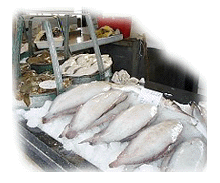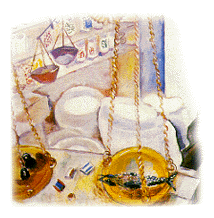|


Fish is prominent on the holiday table, especially on the
New Year and Shavuot. In Jewish lore, it is a symbol of fertility, because
Jacob gave his children a blessing that they should multiply like fish
in the sea. It is also associated with the coming of the Messiah; according
to a legend, the Messiah will come in the form of a great fish from the
sea.[1]
The
custom of eating fish on the Sabbath is apparently an early one,
as the rabbis of the Mishnah (oral law, codified approx. 200 CE)
ruled that it was meritorious to eat fish with each of the Sabbath
meals; references in the Talmud also indicate that it was customary
among Jews to eat fish on Friday night. [2]
In
the Ashkenazi kitchen
East European Jews acquired a liking for freshwater fish from the hundreds
of rivers which crossed the mainly landlocked areas they inhabited. In
the shtetl, fish was brought live on Thursday. It was swimming in tubs
at the market and was kept swimming in the bath till Friday, with several
changes of water to get rid of the muddy taste; on Friday morning it was
killed with a knife or a hammer blow.
 Carp,
pike, perch, sterlet and trout were all grand fish. Édouard de
Pomiane, the French gastronome of Polish origin who wrote about the cooking
of the Jews of Poland, remarked that "every observant Jew eats river
fish. The wealthy buy carp and pike. The poor content themselves with
a miserable roach or sometimes a piece of salt herring." (The poor
also ate tench and chub.) Jewish traders on the silk route were involved
in introducing carp from China to Central and Eastern Europe in the seventeenth
century, and it was Jews who first farmed carp in Poland. They managed
fish ponds and also bred fish from the Black, Azov, and Caspian Seas and
from the river Don. It was the carp, which traveled easily live in tanks,
that they adopted as their fish. Whereas carp became a symbol of the Sabbath,
salt herring, which Jewish merchants also traded and which was a lot cheaper
than fresh fish, was the symbol of the weekday and marked the contrast
between the two. Carp,
pike, perch, sterlet and trout were all grand fish. Édouard de
Pomiane, the French gastronome of Polish origin who wrote about the cooking
of the Jews of Poland, remarked that "every observant Jew eats river
fish. The wealthy buy carp and pike. The poor content themselves with
a miserable roach or sometimes a piece of salt herring." (The poor
also ate tench and chub.) Jewish traders on the silk route were involved
in introducing carp from China to Central and Eastern Europe in the seventeenth
century, and it was Jews who first farmed carp in Poland. They managed
fish ponds and also bred fish from the Black, Azov, and Caspian Seas and
from the river Don. It was the carp, which traveled easily live in tanks,
that they adopted as their fish. Whereas carp became a symbol of the Sabbath,
salt herring, which Jewish merchants also traded and which was a lot cheaper
than fresh fish, was the symbol of the weekday and marked the contrast
between the two.
Many of the old recipes for freshwater fish and herring are now used for
saltwater fish like halibut, haddock, cod, plaice, sole, hake, flounder,
and salmon. Salmon has become the great Jewish party dish, ever-present
at weddings and bar mitzvahs. At my local fishmonger, Corney's, which
specializes in salmon, both wild and farmed, there are always long queues
of people waiting to have theirs filleted or cut into steaks for the Sabbath.
Gefilte fish
Gefilte means "stuffed" in Yiddish. Originally, a fish forcemeat
made from chopped freshwater fish was used to stuff pike or carp skin,
which had been pulled off from head to tail down from the neck. Nowadays,
gefilte fish generally means the forcemeat alone, made into balls and
poached in fish stock. In Britain, the traditional carp and pike have
been replaced by a mixture of saltwater fish.
Gefilte fish evolved as a Sabbath dish because stuffing gives it glamor
and because certain versions eliminate the need to remove bones (which
could be considered a forbidden activity on the Sabbath). There are mentions
of Jewish housewives chopping fish and stuffing fish in Germany in the
early Middle Ages; the fish they used then was pike. Carp, on the ther
hand, was adopted in Poland, Lithuania and the Ukraine. In Poland it was
markedly sweet, while in Lithuania it was peppery. Today Jews of Russian
and Lithuanian background prefer their fish unsweetened, and those of
Polish ancestry still like it sweet. The sweet commercial version called
"Old Vienna" is so named in reference to the large number of
Jews who immigrated to that city from Poland in the nineteenth century.
 Poached
carp served cold Poached
carp served cold
Poached carp served cold in its own jelly is one of the classics of Jewish
cooking. It features in Russian and Polish cookbooks as "in the Jewish
Style." It was usually eaten cold because it was always cooked in
advance for the Sabbath. Those that originate in Poland are sweet. Édouard
de Pomiane complained in 1929 that the Jews cooked a lot of fish but prepared
it in a way which did not appeal to Western tastes. "This is primarily
because of their frequent use of sugar and also large amounts of onions."
He was forced, he said, to add grated horseradish to mask the flavor.
The sweet fish dishes of Polish Jewry are the butt of many Sephardi jokes
in Israel.
Cold fried fish in the Jewish style
The Jews in London had a very particular way of frying fish in batter
and eating it cold which has become a classic of Jewish cooking in Britain.
It was a legacy of the Portuguese Marranos (crypto-Jews) who came to England
in the sixteenth century, many of them via Holland. Manuel Brudo, a Portuguese
Marrano, wrote in 1544 that the favorite dish of Marrano refugees in England
was fried fish. They sprinkled it with flour and dipped it in egg and
in bread crumbs. Lady Judith Montefiore, the anonymous editor-author of
the first Jewish cookbook in England (published in 1846) referred to the
frying oil as "Florence oil," meaning olive oil. At that time
an important community of Marranos in Livorno (where her husband came
from) exported olive oil to England.
Thomas Jefferson, the third President of the United States and a famous
epicurean, discovered "fried fish in the Jewish fashion" when
he came to England. When his granddaughter Virginia put together a collection
of his favorite recipes, she included a recipe for fried fish in the Jewish
manner to be eaten cold....
In the Sephardi kitchen
In all Sephardi communities, fish was appreciated and prestigious. It
was eaten on Friday night and at the end of the Sabbath, and was often
part of the meatless Thursday-evening meal as well. It was grilled, poached,
fried, or simmered in a sauce and eaten cold. Fish roe and fish fritters,
fish balls and little pies were eaten as appetizers with drinks. Fish
was present at holiday feasts and on picnics. In North Africa, outdoor
meals were enveloped with the smells of grilled fish with cumin.
As for the choice of fish, there was plenty around the Mediterranean.
In the sea towns, where many of the Jewish communities were concentrated,
fish represented the great and grand dish. Tunisia and the city of Salonika
were especially famous for their fish dishes. North Africa Jews in general,
and particularly those from Libya, are fond of peppery-hot, garlicky fish.
The Iberian Sephardim acquired a taste for salt cod in Spain and Portugal
and maintained their fondness within the Muslim world, although it was
not liked there. In Algeria they were encouraged in their affection by
the French colonists.
|